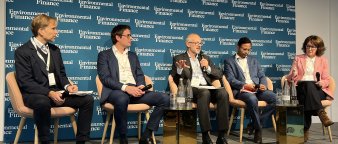This week in Montreal Canada, we hit a major milestone in how our economy treats nature. At the 15th Conference of the Parties to the United Nations Convention on Biological Diversity (COP15), national governments finally agreed on the Global Biodiversity Framework (GBF) in Montreal that will be implemented over the next decade. COP15 is the global summit of nations to negotiate the Global Biodiversity Framework – in essence, the world’s most important tool to protect nature. The Framework has 23 targets that are the roadmap for protecting Earth’s life support systems.
Over the past year and a half, Storebrand has been honoured to co-chair the Public Policy Advocacy working group of the Finance for Biodiversity Foundation together with Federated Hermes Limited. Within this working group, we have advocated for an ambitious and effective outcome of the GBF and called for governments to address alignment of ALL financial flows, both private and public, with the GBF. The increase in public funding for nature cannot be effective if other financial flows remain on trajectories that destroy biodiversity.
Aiming for several critical targets
First, going into the negotiations, we have emphasized that alignment of financial flows rests on two pillars: greening finance, and financing green or mobilizing capital. In other words, increasing positive financial flows and reducing financial flows that harm biodiversity.
Second, we have noted that this alignment relies on mandatory disclosure. Lack of mandatory reporting by companies will limit financial institutions in aligning their financial flows and playing a more positive role for nature unless the voluntary disclosures are significant and material. We need to be able to compare companies; to see what actions they are taking to address risks as well as actions to progress on nature; to objectively identity the leaders and laggards. Based on this position, we have participated in the COP15 process for the past year and a half, as an Observer on behalf of Finance for Biodiversity. We thank the Parties and the CBD for getting a seat around the table, and for the opportunity to be heard.
Big wins achieved
Goal D was a win. We are pleased to see that the Parties recognize the important role that private finance can play to protect nature. However, we can only have that real impact, if the public and the private sectors come together to bridge the finance gap on nature and significantly increase the financial resources committed to tackling biodiversity loss. Although we note that Goal D has no mention of "from all sources" or public and private", this is explicitly referred to in the targets, such as Target 14 and Target 19.
Target 15 was another positive outcome. We are also encouraged to see that governments will ensure that large and transnational companies will have to regularly disclose their impacts and dependencies on nature in a transparent manner. As investors we need company data to guide our investment decisions. While "mandatory" is out, the current text implies that governments will need to ensure disclosure for large companies, along their operations, supply and value chains and portfolios.
Better prepared for the road ahead
As often, sentiments will vary in the aftermath of major negotiations, but a desperately needed leap forward on nature finally happened at COP15. We believe that this is indeed an inflection point, setting up the opportunity for positive change in how we care for nature in our national and global economies.
Now, we must swing into action to build on these steps. I was privileged to participate in the closing high-level session for COP and shared my view on how finance community can act decisively on nature. At Storebrand, we have newly reaffirmed and enhanced our commitments on nature, including most recently our newly adopted Nature Policy, which will guide our investment decisions, as we continue to work to reduce our negative impact on nature and increase our positive contribution. Joining forces to gain influence will also be critical.
Ahead of COP15, a new global investor engagement initiative, the Nature Action 100, was soft-launched as a united front to target and engage companies on the changes necessary to preserve the natural ecosystems that support much of our global economic output.
Our experience working in sustainable investments over the past few decades tells us that the path to ahead won’t necessary be smooth or straight, but COP15 has certainly provided a boost to investors committed to action on nature.







